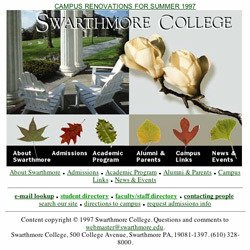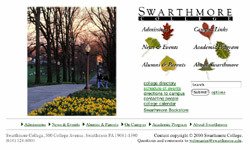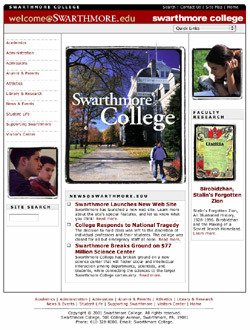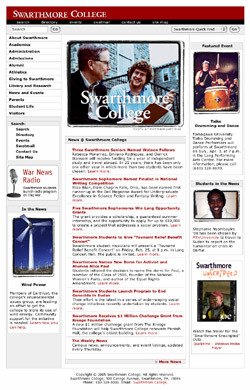 |
www.SWARTHMORE.edu
A look at the past and future
of the college's website
by Eric Behrens '92, Associate Director of ITS |
|
| |
In The Beginning
I was in the corner office of Beardsley Hall the first time I saw a web page. It was 1993. Physics professor John Boccio, then the associate provost for academic computing, pulled me-the most junior employee in the Computing Center-behind his computer screen. He had the sly, proud look on his face that he always had whenever he was about to let somebody in on the Next Big Thing.
The program on his computer was an early version of NCSA Mosaic, the precursor to Netscape and the first example of a modern web browser, complete with flexible linking and digital images that appeared within the body of text.
The possibility and potential of a limitless network immediately made academic technology geeks drool. Since 1991, the College had used a system for distributing text documents called Gopher. But Gopher's lack of presentation flexibility and flair prevented it from sparking a global information revolution. Also around 1991, Boccio's academic computing staff were pioneers in setting up test versions of the very first available web servers. Of course, there were only a few dozen other web sites in the world at the time, so the early days of the web required imagination to understand its potential. Computing Center staff debated whether the web or Gopher would win out in the end. It wasn't long, though, before the open-ended web browser had emerged as what we've since come to call a "killer app."
| |

NetMarket founders Dan Kohn '94, Guy Haskin '94, Roger Lee, and Eiji Hirai '88 in 1994. Photo: Macarthur McBurney '92 |
A constellation of new businesses and media personalities rapidly arrived on the new-media scene. Eiji Hirai '88, Dan Kohn '94, and the rest of the NetMarket crew would soon leave Swarthmore to conduct the first encrypted credit-card transaction over the web. A young Justin Hall '98, now widely considered the Internet's first blogger, began evangelizing around campus about the revolutionary democratic power of writing on the web.
Birth of a Web Site
While the rest of the College was figuring out what we should do with this new medium, the bare bones Computing Center home page served as the College's front door on the web. It was a plain and utilitarian effort with the College logo, some boiler-plate text, and a handful of links on a flat, gray background. The Office of News & Information hired then-recent grad Adam Preset '96 into the College's first position with direct responsibility for managing the design and content of a college-wide web site. His first job was to implement the first true Swarthmore web site.
As time passed, we became more sophisticated about how we communicate with the web. Using the Internet Archive's Way-back Machine, you can see how the Swarthmore site has changed over the years to become a much richer source of information.
| 1997 |
2000 |
 |
 |
| In the web's early days, our home page followed a common convention of listing only a handful of links to general information about departments. |
With images that highlighted the beauty of the Scott Arboretum on every page, the campus was the star of the show. |
In the fall of 2001, News & Information took the College site in a new direction. While still serving the essential functions of navigation, Swarthmore decided to greet its visitors with richer content at the front door.
| 2001 |
2005 |
 |
 |
| Since Fall 2001, the home page has been used to share important news stories and profiles of faculty and student accomplishments. |
The site has continued to enhance the depth and diversity of Swarthmore-related news coverage. |
The New New Site
When we started to explore a new web site design, we knew that we didn't want to reduce our commitment to rich content. We wanted the home page to be a place for genuine and thoughtful communication. To do otherwise would have seemed like a betrayal of our institutional values. Swarthmoreans seek to engage the world, so we needed our web site to behave similarly. At the same time, we wanted to make the site more personal. A school with an 8:1 student-to-faculty ratio has made an implicit statement about the significance of individuals. We were interested in finding ways of downplaying the anonymous voice that often speaks for the College in press releases. We needed to find ways of turning the stage over to the students, faculty, and alumni of the College so that visitors to the site would be able to engage "virtually" with this vibrant, intellectual, socially committed, and open community.
If you have visited the Swarthmore site before, you'll immediately notice the changes in the layout and design of the home page. Our web project team is introducing a warmer, more natural color palette. We have re-worked menus and search tools to improve the ease in finding information. As an example, the full listing of academic courses of study has been promoted to the top level of the site, responding to a demand that stems directly from the interest of prospective students and some alumni. Dozens of contributors from across campus have spent months rethinking the content of their pages, hoping to make them more useful and interesting for their audiences. More improvements in content are yet to come. While we continue to report noteworthy news and events from campus, we also hope that you will enjoy the new editorial focus on the stories we have to share with each other.
If you have feedback to share about the new site, please send it to the web team at www.swarthmore.edu/feedback. We look forward to hearing from you.
After graduating with a degree in Theater Studies, Eric Behrens '92 returned to the College as its first network technician. In addition to heading academic computing in ITS, he has been leading the implementation team for the College's new web site. His self-described "geekiness" extends to blogging at Perpetual Off Night and administering a public Flickr site for Swarthmore photos.
|
|
|